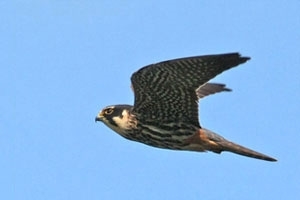Hobby (Falco subbuteo)
 Many of us I’m sure, have played the table football game Subbuteo in the past, but do you know where the name for this game came from? Well, the designer of the game, Peter Adolph, was a keen ornithologist and his favourite species of bird had always been the little falcon called a hobby, whose Latin name is falco subbuteo meaning “smaller than a buzzard” – so he chose it as the new name for his invention!
Many of us I’m sure, have played the table football game Subbuteo in the past, but do you know where the name for this game came from? Well, the designer of the game, Peter Adolph, was a keen ornithologist and his favourite species of bird had always been the little falcon called a hobby, whose Latin name is falco subbuteo meaning “smaller than a buzzard” – so he chose it as the new name for his invention!
The hobby is a bit smaller than a kestrel and has a slate grey back and wings that are long, narrow and pointed, which is combined with a relatively short tail enabling this elegant little falcon to be incredibly agile in flight. It is most often spotted dashing past at speed looking just like an over-sized swift, but should you be lucky enough to see one gliding more slowly overhead, you will notice that its plumage underneath consists of a striped chest and red under its tail.
The first Atlas of Breeding Birds of Britain and Ireland (1968-1971) put the population at only about 100 breeding pairs, mostly confined to the heaths of southern England. However, this population grew rapidly, so that by the late 90s numbers had risen to around 1360 and has today reached in the region of 2,200 breeding pairs. The population has also moved steadily northwards and now the hobby nests in Scotland, which many observers quote as a good example of the evidence of climate change.
The hobby is a summer visitor to this country, arriving in May and choosing an old crow’s nest to breed in, especially, it seems, when sited in a scots pine tree. Eggs are usually laid in June, meaning that the chicks hatch in July and fledging takes place in August. This time of year provides the high speed predator with an abundance of its favourite food, Dragonflies, along with plenty of young house martins and swallows which have recently left the nest, and can be easily taken on the wing by a falcon that can accelerate rapidly and has amazing aerial manoeuvrability. Most of the smaller prey items are also eaten while the bird is still flying along, passing the food from the talons to its beak with great dexterity.
It is not known exactly where British hobbies spend the winter, as there have never been any ringing recoveries south of Spain – and no hobbies ringed anywhere in Europe have been recovered south of the Sahara. Most ringed hobbies recovered in Europe on migration appear to have been heading in a south-westerly direction, towards West Africa, but the main wintering area for this species is believed to be the Zambezi basin.
So, if you are out enjoying a warm summer’s evening and you suddenly hear the shrieking, high pitched alarm calls of martins and swallows – quickly look to the skies as you might just get a glimpse of this exciting little falcon as it dashes overhead.
Peter Thompson
Advisory

Download Peter Thompson's essential 26-page book, featuring beautiful photography and detailed profiles of Britain's wildlife
Download FREE >